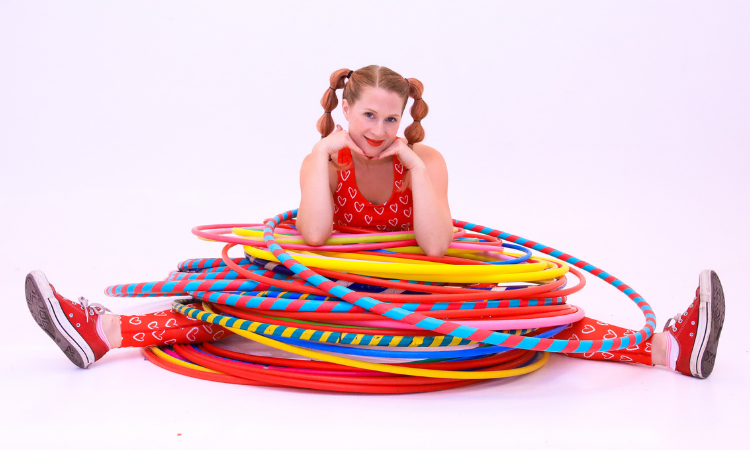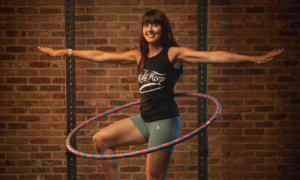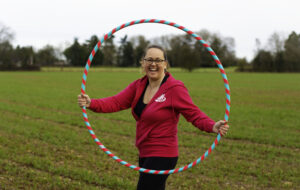So you decide that you want to take up hula hooping. Great decision! The next step is picking your first hula hoop. However, there are so many different types of hoops out there it can get totally confusing. Luckily, we have you covered. At HulaFit, we’ve got many years of hula hooping under our belt (or should we say on our waist?😉) so we’re going to introduce you to all the different types of hoops and their different uses. Let’s take a look and find out which hula hoop is best for what.
Weighted hula hoops
As a hula hoop fitness brand, of course, we’ll start with the classic weighted hoop. Weighted hoops are large hoops that have a metal core layer making them heavy. The heaviness helps with momentum, and it makes your abs work hard to keep the hoop spinning – helping to build muscle. In our blog What hoop should I buy as a beginner? We go into much more detail about sizes and what to look for. When you’re wondering which hoop is best for fitness, our top tips are:
- Avoid anything over 1.25kg – they can be painful to use, can cause serious bruising and come with a higher risk of injury.
- Aim for something 40 inches in diameter, or more if you are taller or have a larger waist.
- Avoid hoops marketed as massage hoops with lumps and bumps on them – again, this can cause nasty bruising.
- Try and find a hoop with grip tape – or add your own. Grip tape reduces slipping which helps you keep the hoop spinning.
As these hoops are weighted they are not suitable for spinning on your arms, neck, or knees – we don’t want you to hurt yourself.
Great for: Fitness and hula hoop workouts, beginners, waist hooping, hip/booty hooping (below the hip bones, though! Hooping on your hip bones is a one-way ticket to bruise city!)
Not great for: hoop tricks, hooping anywhere other than your waist and hips. Not suitable for children to use.
Size suggestions: 38-inch diameter if you are petite, 40-inch for medium or a 44-inch diameter for plus-sized folks – or even larger if that’s the one that works for your body.
MDPE hula hoops
MDPE hula hoops are made from the plastic used in plumbing pipes. You can even head to a local hardware store, pick up some piping and DIY one if you want to!
MDPE hula hoops come in all shapes and sizes. You’ll often see them with colourful grip tape – the gaffer tape helps the hoop grip to your body more easily – plus it looks great!
As these are lighter than the weighted hoops, you can use them to spin on different parts of your body, such as learning to hoop on your chest, or on your knees. Larger hoops are easier while you’re learning these techniques, but one you get the technique, you’ll probably want to downsize your hoop.
These are great hoops for learning a classic beginner hula hoop move where you move the hoop from spinning on your waist to spinning on your hand above your head like a lasso.
You can also use MDPE hoops for hula hoop workouts, such as an online HulaFit class.
Great for: Waist hooping, learning chest hooping, learning knee hooping, learning moves like the corkscrew/waist to lasso
Bad for: MDPE hoops are too heavy for some tricks with your hands, eg isolations, multi-hooping.
Size suggestions: 36-38 inch diameter if you are petite, 40inch for medium or a 44inch diameter for plus-sized folks
Kid’s hoops/small hoops
Even though you should steer clear of these for waist hooping, there are a variety of tricks that you can actually do with those small kid’s hoops that you see in hardware stores. As they are lighter and with a smaller diameter than MDPE hoops, they’re great for tricks using your hands. You can learn to spin a hoop on your hand, your arm, your neck, learn escalators and all kinds of fun tricks without needing to spin on your waist.
Small kids’ hoops move super quickly around your body, that’s why they’re fiendishly difficult to keep spinning on your waist.
You don’t have to buy a cheap one though – there are some great collapsible small hoops, such as the Play Perfect hoop.
Great for: Kids hooping, learning tricks on your hands, arm hooping, neck hooping, foot hooping, twin hooping.
Bad for: waist/chest/knee hooping – it’ll just fall down!
Sizes: For spinning two hoops/twin hooping 26 – 32 inch diameter (depending on how tall you are or if you want to use them as your main hoop), kid’s hoops – 30-inch diameter. For single hooping, a 32-inch diameter is a great first hoop size.
Polypro
For learning off body tricks – polypro is a go-to – they’re designed for tricks and will last you longer than a kid’s hoop. Most keen hoopers have a polypro hoop. It’s a lightweight material that makes the hoop very light and responsive. This is great if you know what you’re doing, but can make learning some moves harder.
Good for: twin/double hooping, hoop tech, tricks, flow.
Bad for: beginner hoopers.
Goldilocks
Goldilocks hoops are not too heavy, not too light, but juuust right – we assume that’s where their name comes from! These hoops are made from polypro but slightly thicker tubing, which means they are easier to control – they are an intermediary choice between HDPE and polypro. These are a great choice for on-body hooping, such as multip hooping and hoop splitting (eg spinning a hoop on your chest, waist and knees), or you can use them for all the fun fancy tricks in your hands too!
Good for: multi-hooping, hoop splitting, tricks
Bad for: workouts – too light
Smart hoops
OK, so these technically aren’t hula hoops, but they’re taking the fitness world by storm so they need addressing. Smart hoops are essentially belts with a weight on a string. You mimic the hula-hooping action to work your abs as the weight spins around the belt.
These are purely for fitness as there’s not much else you can do with them beyond spinning on your waist. As you can imagine, we prefer a classic hula hoop instead.
Top tip: make sure you are pulsing your belly back and forward with this. A lot of people get the weight spinning by working pushing with their legs or circling their hoops, which won’t give your stomach the workout that you’re looking for.
Good for: Small spaces, or when you don’t want the hoop to crash to the floor
People who want the benefits of hula hooping but can’t nail the technique with a circular hoop (come to a HulaFit class – we’ll help you!).
Bad for: You can develop bad habits, such as working your legs instead of your abs.
It’s very limited in what you can do with it – it could get boring quickly!
In summary
Is there a perfect hula hoop that does everything? No! Does this mean your hula hoop collection will grow? Absolutely!
Most hoopers have different hoops to do different things – some for on-body, some for tricks and some for working out. It all depends on what kind of hula hooping you’d like to do.
Is it time to take the plunge and treat yourself to a hoop? Check out the HulaFit store today. Or if you fancy something lighter, use HulaFit Director Carla’s discount code Cahula for a cheeky 10% off at HoopSpin!





